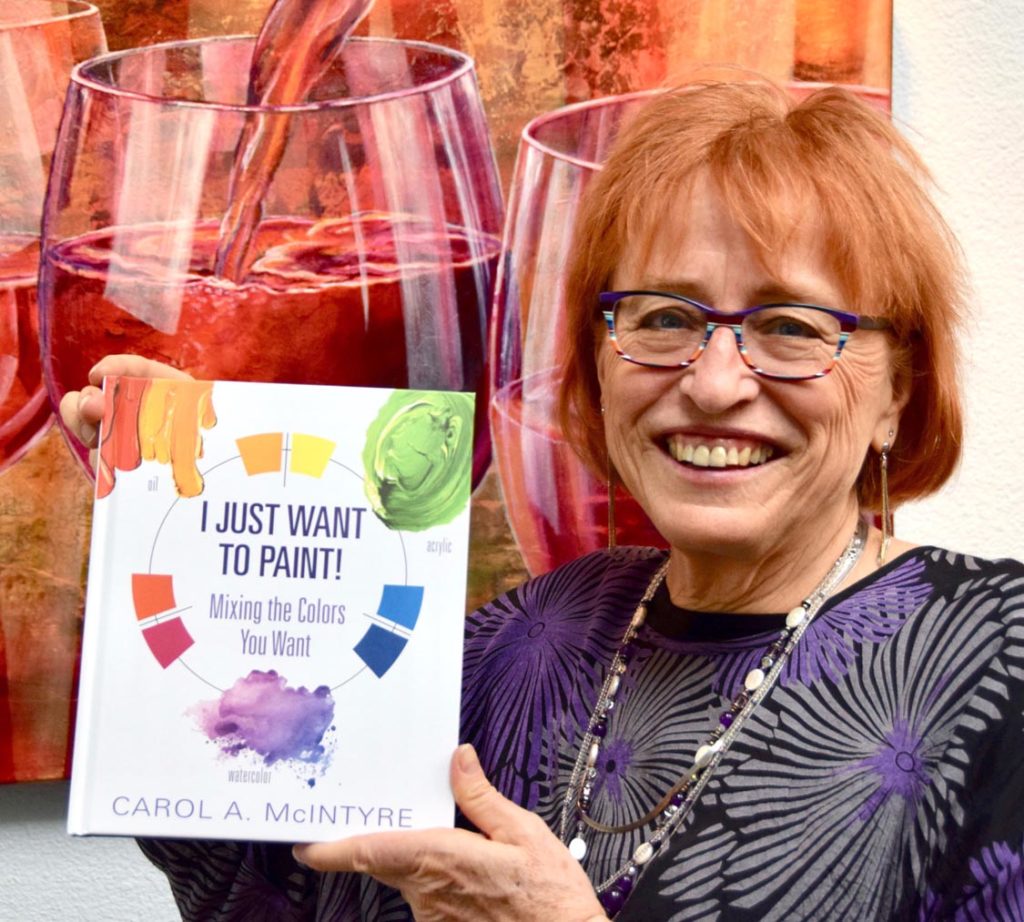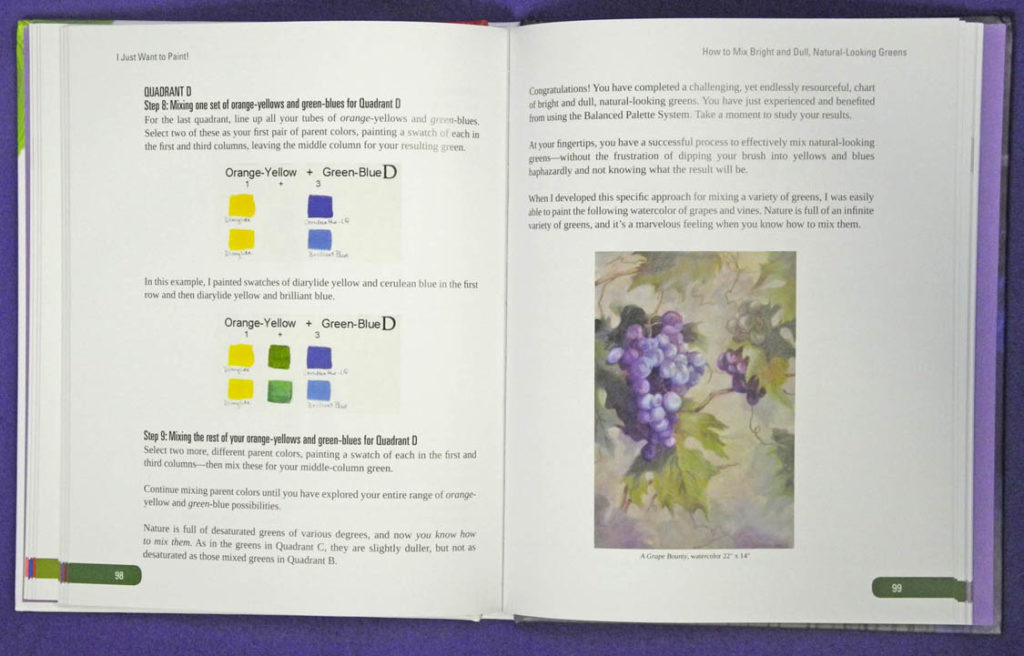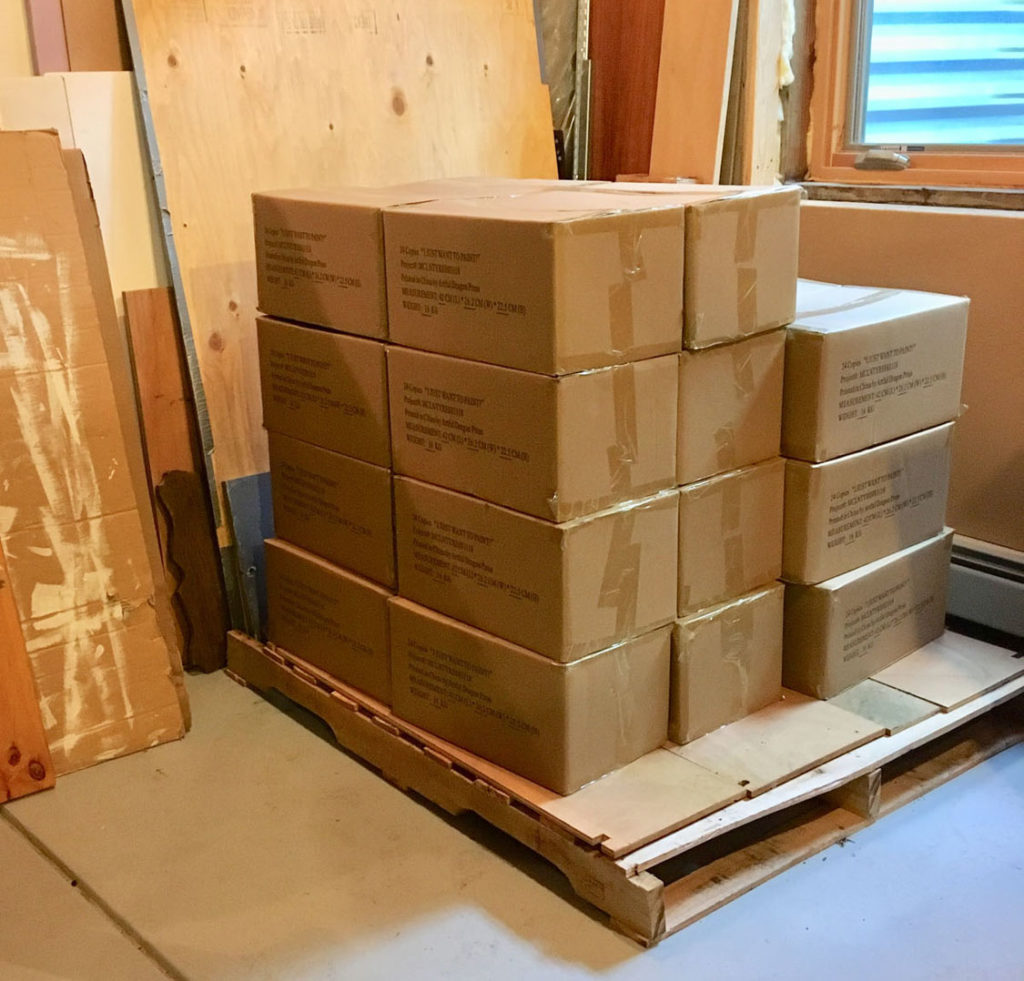by guest writer Carol McIntyre
Eight questions to ask yourself before publishing a book.
You have written the first draft of your non-fiction manuscript, now what? Celebrate and give yourself kudos because you have accomplished something few have. It’s been an arduous task. There were moments when you didn’t think you would finish. But, what’s next? To self-publish or not?
This was the first question I had to answer once I finished the draft for, I Just Want to Paint! Foremost, as a visual artist for over 30 years, painting was, and is, my first love. Along the way, I began writing a memoir about creating a large body of work. After that, I became a blogger with a focus on color theory when I discovered too many painters were frustrated―their creativity thwarted―because they didn’t know how to easily mix color. This led me to writing and publishing I Just Want to Paint: Mixing the Colors You Want! in February 2019.
Given my past writing experience, plus attending a workshop on book publishing and listening to various related webinars, I thought I was prepared for the adventure. No, I was not. Once the writing process ended, I entered a publishing world that quickly became foreign to me.

Carol A. McIntyre with her book and in front of one of her paintings
First, there is no one-way to go about publishing a book. However, here are some essential questions you can ask yourself.
1. Are you willing to add another business to your full-time art business?
Time is our most valued commodity and most of us already live full lives. Self-publishing takes enormous amounts of time and energy because it is a different business with multiple learning curves. Do you have time to spare? What are you willing to give up in order to publish a book? Are you ready to sacrifice not having time for your usual events, relationships and other activities?
You are most likely a full-time artist who wants to write a book because you have information and/or an experience you want to share with others, and you believe it will have an impact. You may also want to write a book to get your art in front of more people and increase your professional credibility. Whichever your motivations, analyze your expectations and make sure the book is in sync with your current business.
2. What problem will your book solve for your readers and what is your why?
Humans are hard-wired to identify a problem and we want it solved easily and quickly. As a non-fiction writer, it is important to articulate the problem, or problems, you want to solve for your readers, and then to present solutions that are easily understood.
Once you know the problem you will solve, what is your why? Spend time journaling about your book concept and why you are writing it. Too many authors publish without taking the time to answer these basic questions. When this happens, books do not sell.
For example, I have been studying and teaching color theory for several decades. My “why” is to help frustrated painters of all media to stop making mud so they can unleash their potential and start more fully expressing their artistic vision.
3. Who will read your book and is it a viable market?
Given the problem you want to solve and your why, who will read your book? This question and the ones above are not quickly answered. It will take time several iterations to find the answers. After you have articulated these to the best of your ability test them with potential readers.
Conducting research is another vital step. For example, I took the 30+ books I owned about color theory and spent time analyzing them. I discovered no book existed that taught painters how to mix color in a clear, concise way. A step-by-step method to mixing color was missing!
Once I established this concept, then I needed to identify the core personality of the person who would want to read my book. I wrote down a generic name for this fictionalized, yet researched, person with all her characteristics, motivations, and demographics, so that she was forefront in my mind as I continued to edit and produce my book. Later, this also helped define the market for my book.

An interior view of I Just Want to Paint!
4. Are you prepared to develop a marketing plan for your published book?
Once you know your what, why and who, then it is time to map out a marketing plan. Marketing begins once the first draft of your manuscript is completed, not later. Initially, this plan is broad in scope and then gets honed the further along the publishing road you travel.
A marketing plan is a road map that will help you through the myriad of options available for selling your book. You will quickly discover there are more opportunities and marketing activities to engage than you thought possible. It becomes overwhelming. To traverse these, you need goals and a clear plan.
5. Do you have $5,000-15,000 to publish your book?
Really? It takes this much money? Yes. This investment is not expended all at once and can extend over a year or more. This financial commitment is necessary for: editing (you will need at least three different types of editors), designing (cover and interior), photography, various fees, printing, consultants/experts, book web page, marketing copywriter, book awards, launch party, marketing materials, advertising, audio recording, e-book design, packaging, shipping, storage, and the list goes on.
Though I tried early on to have two different book-publishing consultants outline the potential costs of publishing my book, neither were forthcoming nor did they hint at all the unexpected expenses. And lest I forget, bookstores and other retail outlets take at least 40% of your list price and Amazon takes 55%. Recouping your expenses will take time.
6. Do you have an existing fan base or platform from which to market your book?
For a non-fiction book in today’s publishing world, the most successful authors are those who have a platform with many followers. For example, you can be a teacher, speaker, coach or blogger. When I started marketing my book, I had an email list of 2,200, and 2,800 Facebook followers, which I do not believe was enough. They gave me a great jump start with sales, but I have much more to do in the way of teaching and speaking to ensure I accomplish my why.
7. Are you willing to learn about an entirely different industry?
Book publishing is complex and constantly changing. The big and small players in the industry move around a chess board. Learning about the distribution networks, such as selling to libraries, is mind-boggling. As a publisher, you are suddenly in the retail and wholesale business. This means dealing with returns, unhappy customers, damaged books, happy customers, e-commerce systems, bookkeeping details, follow-up filing system, etc.
Once you start selling, you alone are responsible for labeling, packaging, signing and shipping, documenting each sale. When I realized that I could not travel because of book orders, I had to find a fulfillment company. This became another learning curve and expense.

Thirty of the sixty boxes of I Just Want to Paint! in our basement
8. You have 500/1,000/5,000 books in your basement, now what?
It’s thrilling to publish a book you know will impact the world. Seeing them arrive in my driveway, cutting open that first box and then feeling I Just Want to Paint! in the flesh was a joy to behold. I had done it! Bring out the champagne! However, and I don’t like bursting the bubble, the reality of all these books hit me hard a few days later. I remember saying to my husband, “What was I thinking?”
In many ways, publishing is like giving birth. A book has its own personality and destiny that will set you on an unpredictable ride. The rewards and surprises will be numerous, as well as the hurdles and frustrations. Reportedly, 80% of us have a book within us to write. How many of us will publish? It has been said that writing your manuscript is the easiest phase of book publishing… and in comparison to what follows, I agree.
If you choose to venture into the book publishing world, do it with strong conviction and with a network of personal and professional support. Writing is a singular activity, but publishing requires a team.
Note and a bit of history: I Just Want to Paint! is a quality, well-designed, hardback non-fiction book with sewn binding and 126 illustrations. Color is on every page. 1,500 copies were printed with the intent of selling on Amazon and in art stores, libraries, independent bookstores, schools and art centers, as well as off my website.
Learn more about I Just Want to Paint: Mixing the Colors You Want! here. View Carol McIntyre’s paintings here.
Guest writer Carol McIntyre has helped over 3,500 painters see and mix color differently. She is an award-winning artist who is a signature member of the Transparent Watercolor Society of America and holding associate memberships with the Oil Painters of America and the American Women Artists. She is available as a workshop instructor and one-on-one coach with color as her specialty.


Thanks for sharing your journey! I can’t wait to order my copy of your book. Wishing you great success.
Very nice article with lots of thoughtful information. Your book looks great and I wish you the greatest of success with it!
I’m sure other people will mention this eventually, but another alternative to the actual printing part of this process is to use a Print-on-demand service (there are many to choose from ), but it too has pros and cons:
PROS: you don’t have to warehouse stock, less waste for the environment, your costs are greatly reduced, they can be printed all over the world so your international customers can order and pay less shipping costs, if set up properly you can still sell them thru Amazon, you control the final price and thus your royalty fee.
CONS: you have less control over the quality, you have to make your books fit withing the POD services size requirements, libraries and bookstores sometimes do not support POD books unless you register them properly and provide them with a proper ISBN, you have to do most or all of the marketing
But writing a book is a HUGE investment in time. It took me 2 years to complete my book, “Fairy Houses” and I had a publisher and an art department doing the layout. Still, it WAS worth it!
Thanks for sharing your experience, Sally. Self-publishing is definitely an alternative option, and it sounds like you have navigated that path.
Hi Sally, I looked into the POD process and because of all the color in my book and the intricate interior layout design (several exercises and accompanying images), it is not a viable option. The result would most likely be a mess. This is also why I cannot offer a Kindle version. It is for many other types of books. Thanks for your comment/suggestion.